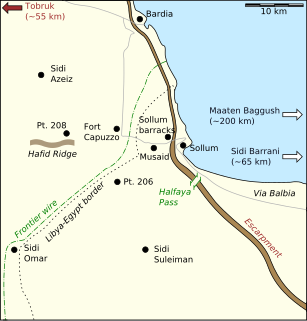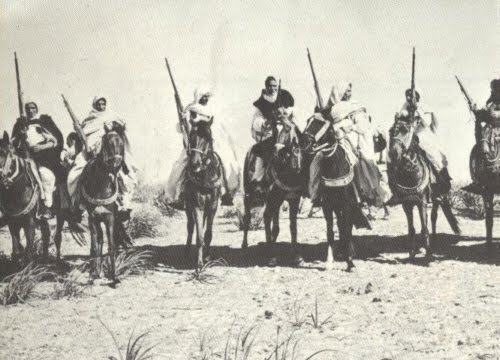
Cyrenaica is the eastern coastal region of Libya. Also known as Pentapolis in antiquity, it formed part of the Roman province of Crete and Cyrenaica, later divided into Libya Pentapolis and Libya Sicca. During the Islamic period, the area came to be known as Barqa, after the city of Barca.

The Senussi or Sanusi are a Muslim political-religious tariqa and clan in colonial Libya and the Sudan region founded in Mecca in 1837 by the Grand Senussi, the Algerian Muhammad ibn Ali as-Senussi. Senussi was concerned with what he saw as both the decline of Islamic thought and spirituality and the weakening of Muslim political integrity.

Marshal Rodolfo Graziani, 1st Marquis of Neghelli, was a prominent Italian military officer in the Kingdom of Italy's Regio Esercito, primarily noted for his campaigns in Africa before and during World War II. A dedicated fascist, he was a key figure in the Italian military during the reign of Victor Emmanuel III.

The Libyan Desert forms the northern and eastern part of the Sahara Desert. It describes that part of the Sahara that lies within the present-day state of Libya; it also historically describes the desert to the south of Ancient Libya, a territory which lay to the east of the present-day state. The Libyan Desert is one of the driest, harshest and most remote parts of the Sahara, the world's largest hot desert. This extended desert country is barren, dry and rainless.

Fort Capuzzo(Ridotta Capuzzo) was a fort in the colony of Italian Libya, near the Libyan-Egyptian border, next to the Italian Frontier Wire. The Litoranea Balbo(Via Balbia) ran south from Bardia to Fort Capuzzo, 13 km (8 mi) inland, west of Sollum, then east across the Egyptian frontier to the port, over the coastal escarpment. The fort was built during Italian colonial repression of Senussi resistance in the Second Italo-Senussi War (1923–1931), as part of a barrier on the Libya-Egypt and Libya-Sudan borders.

Lion of the Desert is a 1981 Libyan historical epic war film about the Second Italo-Senussi War, starring Anthony Quinn as Libyan tribal leader Omar Mukhtar, a Bedouin leader fighting the Regio Esercito and Oliver Reed as Italian General Rodolfo Graziani, who attempted to defeat Mukhtar. It was directed by Moustapha Akkad and funded by the government under Colonel Muammar Gaddafi. Released in May 1981, the film has received positive reviews from critics, but performed poorly at the box office, gaining revenues of US$1.5 million worldwide despite having a $35 million budget. The film was banned in Italy in 1982 and was only shown on pay TV in 2009.

Jaghbub is a remote desert village in the Al Jaghbub Oasis in the eastern Libyan Desert. It is actually closer to the Egyptian town of Siwa than to any Libyan town of note. And like Siwa, its population is Berber. The oasis is located in Butnan District and is the administrative seat of the Jaghbub Basic People's Congress. Supported by reservoirs of underground water and date production, the town is best known for its hard-won self-sufficiency. Idris of Libya was born in Jaghbub on 12 March 1890.

The history of Libya as an Italian colony began in the 1910s and lasted until February 1947, when Italy officially lost all the colonies of the former Italian Empire. It can be divided in two periods: the first from 1911 to 1934 called "Italian colonization" and the second from 1934 called "Italian Libya".

Hussein Yousef Maziq a Libyan politician was Prime Minister of Libya from 20 March 1965 to 2 July 1967. He was one of the most important men in the Kingdom era of Libya.
Muhammad ibn Ali as-Senussi in full Sīdī Muḥammad ibn ʿAlī al-Sanūsī al-Mujāhirī al-Ḥasanī al-Idrīsī, (1787–1859) was an Arab Muslim theologian and leader who founded of the Senussi mystical order in 1837. His militant mystical movement proved very significant and helped Libya to win its freedom from Italy on 10 February 1947. Omar Mukhtar was one of the most significant leaders of the Senussi military campaign launched by Muhammad ibn Ali as-Senussi. Al-Sanūsī’s grandson Idrīs I ruled as king of Libya from 1951 to 1969.

The Frontier Wire was a 271 km (168 mi) obstacle in Italian Libya, along the length of the border of British-held Egypt, running from El Ramleh, in the Gulf of Sollum south to Jaghbub parallel to the 25th meridian east, the Libya–Egypt and Libya–Sudan borders. The frontier wire and line of covering forts, were built by the Italians during the Second Italo-Senussi War (1923–1931), as a defensive system to contain the Senussi population, who crossed from Egypt during their resistance against the Italian colonisers. From the Italian declaration of war on 10 June 1940 to late 1942, it was the scene of military engagements between Italian, British and German forces as the fighting ebbed and flowed across the frontier.

Italian Libya was a colony of the Kingdom of Italy located in North Africa, in what is now modern Libya. Italian Libya was formed from the Italian colonies of Cyrenaica and Tripolitania that were taken by the Kingdom of Italy from the Ottoman Empire in 1911, during the Italo-Turkish War of 1911 to 1912. The unified colony was established in 1934 by governor Italo Balbo, with Tripoli as the capital.

Italian Cyrenaica was an Italian colony, located in present-day eastern Libya, that existed from 1912 to 1934. It was part of the territory conquered from the Ottoman Empire during the Italo-Turkish War of 1911. In 1934, it became part of Italian Libya.
The Libyan resistance movement was the rebel force opposing the Italian Empire during its Pacification of Libya between 1923 and 1932.

Suluq is a town in the Benghazi District of the Cyrenaica region in northeastern Libya. It is located about 53 kilometers to the south-east of Benghazi.

Sharif El Gariani (1877–1945) was a Libyan religious sheik and statesman.

Ahmed Sharif as-Senussi was the supreme leader of the Senussi order (1902–1933), although his leadership in the years 1917–1933 could be considered nominal. His daughter, Fatimah el-Sharif was the Queen consort of King Idris I of Libya.

Fascist Italy maintained several concentration camps in Cyrenaica during the later phase of its occupation of that country. After the initial invasion in 1911, the Italian control over much of the country remained ineffective. In the face of the armed Arab opposition, mainly in Cyrenaica under the leadership of Omar Mukhtar, Italian forces under the Generals Pietro Badoglio and Rodolfo Graziani waged punitive pacification campaigns which turned into brutal and bloody acts of repression.

The Pacification of Libya or Second Italo-Senussi War, was a prolonged conflict in Italian Libya between Italian military forces made mainly by colonial troops and indigenous rebels associated with the Senussi Order that lasted from 1923 until 1932, when the principal Senussi leader, Omar Mukhtar, was captured and executed.

For the town near Tripoli, see Janzur.



























